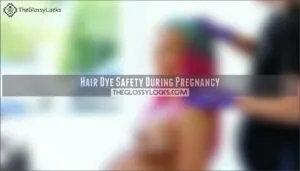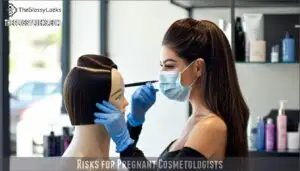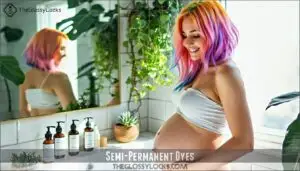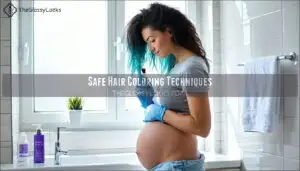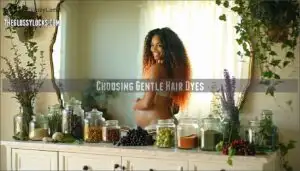This site is supported by our readers. We may earn a commission, at no cost to you, if you purchase through links.

Most experts suggest waiting until your second trimester when the baby’s major organs have developed.
Opt for techniques that minimize scalp contact, like highlights, balayage, or semi-permanent dyes with natural ingredients.
Always color your hair in well-ventilated areas and wear gloves to reduce chemical absorption.
While research hasn’t definitively linked hair dye to birth defects, it’s smart to play it safe.
Think of pregnancy as the perfect time to embrace those roots—many women find their hair looks better than ever during these nine months anyway.
Our expert recommendations might surprise you, and considering the importance of natural ingredients and well-ventilated areas can make a difference.
Table Of Contents
- Key Takeaways
- Hair Dye Safety During Pregnancy
- Precautions for Hair Treatments
- Risks for Pregnant Cosmetologists
- Safe Hair Dye Options
- Top 5 Safe Hair Dyes
- Hair Coloring and Breastfeeding
- Safe Hair Coloring Techniques
- Choosing Gentle Hair Dyes
- Frequently Asked Questions (FAQs)
- What hair dye is safe while pregnant?
- How long should you wait to dye your hair after pregnancy?
- Can you get a Brazilian hair treatment while pregnant?
- Can I get balayage while pregnant?
- Can hair dye affect babys hair color?
- Do pregnancy hormones alter dye effectiveness?
- Is root touch-up safer than full coloring?
- How soon postpartum can I color hair?
- Will hair dye affect prenatal testing results?
- Conclusion
Key Takeaways
- You’ll minimize risks by waiting until your second trimester to color your hair, when your baby’s major organs have already developed.
- You can opt for safer techniques like highlights, balayage, or semi-permanent dyes that minimize scalp contact and chemical absorption.
- You should always color your hair in well-ventilated areas and wear gloves to reduce chemical exposure for both you and your baby.
- You can choose pregnancy-safe options like ammonia-free products, vegetable-based dyes like henna, or brands specifically formulated with natural ingredients.
Hair Dye Safety During Pregnancy
You can still maintain your hair color during pregnancy, as research shows hair dye chemicals have minimal skin absorption and pose low risk to your baby.
While most experts consider dyeing safe, especially after the first trimester, it’s smart to take simple precautions like choosing gentler products and ensuring good ventilation.
Chemicals in Hair Dyes
What’s actually lurking in those hair dye bottles you’re eyeing? Most conventional hair dyes contain chemicals like ammonia, PPD alternatives, and resorcinol exposure that raise concerns during pregnancy.
While parabens and phthalates present potential risks to development, modern safe hair color options have reduced these chemicals substantially.
Many pregnancy hair dye formulations now avoid harsh ingredients without compromising results, making hair dye safety less worrisome than in previous decades.
Some dyes also contain ingredients that can lead to dry and brittle hair, so reading labels is important.
Minimal Skin Absorption
Your healthy scalp serves as a protective barrier against hair dye chemicals. Research shows minimal skin absorption occurs during coloring sessions, offering peace of mind for expecting moms.
- Dye molecule size limits penetration through intact scalp
- Application methods impact exposure—foils minimize scalp contact
- Exposure duration directly affects absorption rates
- Individual variation exists in skin permeability
- Healthy skin without cuts reduces dermal absorption substantially
Low Risk to Fetus
Because your hair only absorbs a tiny amount of dye chemicals, your developing baby faces minimal risk.
The placental barrier acts as your little one’s bodyguard, filtering out most harmful substances.
| Trimester | Risk Level | Why | Expert View | Recommendation |
|---|---|---|---|---|
| First | Higher | Critical development | Cautious approach | Best to wait |
| Second | Low | Placenta established | Generally safe | Good time to color |
| Third | Low | Fetal wellbeing secured | Safe with precautions | Go ahead with care |
| Postpartum | Minimal | No direct fetal exposure | Safe option | Perfectly fine |
| Breastfeeding | Very low | Negligible milk transfer | Safe with hygiene | Enjoy your refresh |
The provided table outlines the risk levels associated with each trimester and postpartum, including breastfeeding, to help guide your decision on when it is generally safe to color your hair.
Precautions for Hair Treatments
You’ll need to take extra precautions with hair treatments during pregnancy to protect both you and your growing baby.
While most hair coloring is considered low-risk, following simple safety measures like waiting until your second trimester and ensuring proper ventilation can substantially reduce any potential concerns.
Waiting Until Second Trimester
The first trimester marks a pivotal time for fetal development, which is why doctors recommend waiting until your second trimester for hair coloring during pregnancy.
Your hormonal changes have settled by weeks 13-26, making this timing ideal for treatments.
You’ll enjoy peace of mind knowing the critical organ formation period has passed, and many pregnancy-safe dyes work best during this window when your body’s adjusted to pregnancy’s demands.
Well-Ventilated Areas
The salon’s air quality plays a vital role in your hair coloring safety during pregnancy.
Always choose a well-ventilated area where those hair dye fumes can’t linger around you. Open windows, turn on fans, or consider DIY ventilation by setting up a portable fan facing outward.
Many hair salons today have updated ventilation systems specifically designed to reduce fume inhalation—worth asking about when booking your appointment to ensure a safer experience with well-ventilated areas.
Following Package Directions
Beyond having good air flow, you should treat package directions like a sacred pregnancy manual. Hair dye instructions aren’t just suggestions—they’re safety guidelines specifically designed to protect you and your little one.
When coloring your hair while pregnant, it’s essential to follow the instructions carefully. Manufacturers include these precautions for good reason—skipping steps might increase chemical exposure risks.
To ensure your safety, always follow these guidelines:
- Never exceed the recommended application time
- Always perform patch testing 48 hours before full application
- Rinse thoroughly until water runs completely clear
Risks for Pregnant Cosmetologists
If you’re a cosmetologist working with hair chemicals during pregnancy, you’ll face higher exposure risks than clients getting occasional treatments.
You’ll need to take extra precautions like wearing gloves, ensuring proper ventilation, and taking regular breaks to substantially reduce your risk of complications.
Increased Chemical Exposure
As a pregnant cosmetologist, you’re facing nearly triple the chemical exposure compared to clients.
Your daily work routine puts you in constant contact with salon chemicals for extended periods.
| Exposure Type | Risk Level | Protective Measures |
|---|---|---|
| Direct skin contact | High | Wear gloves, aprons |
| Inhalation | Very high | Salon ventilation, masks |
| Duration | Moderate | Take frequent breaks |
| Frequency | High | Rotate tasks when possible |
Protective gear and proper cosmetologist precautions can substantially reduce hair dye risks while maintaining your career, by ensuring you take frequent breaks and use salon ventilation.
Higher Miscarriage Risk
While chemical exposure is concerning, research suggests a potential connection between salon work and higher miscarriage risks.
Studies show cosmetologists who frequently apply bleaches and permanent dyes may face increased risks.
Four factors that influence these risks include:
- Working over 40 hours weekly
- Poor salon ventilation systems
- Frequent application of chemical treatments
- Limited breaks between client services
Remember, study limitations exist, and correlation doesn’t always mean causation.
Proper Precautions
When working as a cosmetologist during pregnancy, your safety demands proper precautions to minimize chemical exposure.
Here’s what you need to know:
| Precaution | Why It Matters | How To Implement |
|---|---|---|
| Glove Usage | Prevents skin absorption | Wear nitrile gloves, not latex |
| Ventilation Importance | Reduces fume inhalation | Work near windows with fans |
| Timing Matters | Limits exposure duration | Take regular breaks |
| Patch Testing | Identifies allergic reactions | Test products 48 hours before use |
The provided table outlines key precautions to take, including glove usage, ventilation importance, timing matters, and patch testing, all of which are crucial for minimizing chemical exposure and ensuring a safe working environment.
Safe Hair Dye Options
You can still maintain your hair color during pregnancy with safer alternatives that won’t compromise your baby’s health.
Semi-permanent dyes, vegetable-based options like henna, and highlighting techniques that don’t touch your scalp are excellent choices for expectant moms who aren’t ready to embrace those surprise grays just yet.
Semi-Permanent Dyes
Looking for gentler options during pregnancy? Semi-permanent dyes offer a safer alternative with fewer harsh chemicals and no developer or ammonia.
These color treatments gradually fade rather than grow out, reducing your overall chemical exposure.
- Most semi-permanent formulas wash out after 8-12 shampoos, making the fading process predictable
- Application techniques are simpler—just apply and rinse, no mixing required
- Color longevity varies by brand, so check brand comparisons before purchasing
- Many contain plant-based ingredients for improved ingredient safety compared to permanent options
Some may even explore novelty pregnancy options during this time, considering safer alternative and semi-permanent dyes for their benefits, including the fact that they gradually fade.
Permanent Dyes With Natural Ingredients
While semi-permanent options work well for some, many moms-to-be prefer the lasting results of permanent color.
Today’s plant-based permanents offer gentler alternatives to traditional dyes. Brands like Naturtint and Herbatint use plant-infused formulas that are ammonia-free, paraben-free, and vegan.
These organic hair color options contain nourishing ingredients like aloe vera and witch hazel while still providing rich, long-lasting coverage. For a wide selection, explore these plant based options.
You’ll get the look you want without compromising on pregnancy safe dye choices.
Vegetable Dyes
Many vegetable dyes offer a completely natural alternative for coloring your hair during pregnancy. These plant-based options provide gentle coverage without harsh chemicals.
- Henna safety is well-established, making it a pregnancy safe dye that delivers auburn to red tones
- Indigo options can be mixed with henna for darker shades and excellent gray coverage
- DIY recipes using herbs like chamomile or coffee boost color longevity while nourishing your hair
For those seeking alternatives, consider that ammonia damages hair, which is why vegetable dyes are a great option, providing a natural way to achieve desired hair color without the risks associated with chemical dyes.
Top 5 Safe Hair Dyes
You’ll find these five pregnancy-safe hair dyes offer beautiful results without the worry of harmful chemicals.
From ammonia-free Schwarzkopf Simply Color to plant-based Herbatint, these options let you maintain your style while keeping your growing baby protected.
1. Schwarzkopf Simply Color Intense Espresso
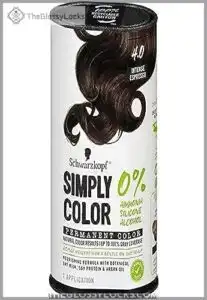
For pregnancy-safe hair coloring, Schwarzkopf Simply Color Intense Espresso stands out as a gentle powerhouse.
This dermatologist-tested formula skips harsh chemicals like ammonia, PPD, and PTD while delivering up to 100% gray coverage.
You’ll appreciate its nourishing blend of oat milk, soy protein, and argan oil that leaves hair looking healthy after coloring.
The cream-based formula applies easily and works on all hair textures.
For best results, perform a patch test 48 hours before use and leave the color on for 30 minutes.
Plus, its eco-friendly packaging shows you care about more than just great hair, with a formula that is also dermatologist-tested.
Best For: Those seeking a pregnancy-safe, low-irritant, and chemical-free hair dye with eco-friendly packaging.
- Gentle, ammonia-free, and dermatologist-tested formula.
- Nourishing blend of oat milk, soy protein, and argan oil.
- Provides up to 100% gray coverage with a natural finish.
- Color may fade within two weeks for some users.
- Conditioner included might not be as effective as standalone products.
- Results may not meet salon-level expectations.
2. MANIC PANIC Hot Hot Pink
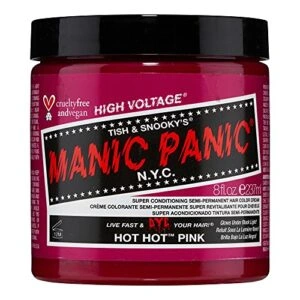
MANIC PANIC Hot Hot Pink stands out from the crowd as a pregnancy-friendly option.
This semi-permanent dye lasts 4-6 weeks without harsh chemicals and contains 98% conditioner to nourish your hair.
You’ll appreciate that it’s both vegan and cruelty-free—a status it’s maintained since 1977.
For expecting moms concerned about safety, it’s generally considered low-risk during pregnancy, though you should still consult your doctor first.
The vibrant, UV-reactive formula works best on pre-lightened or virgin hair and doesn’t require a developer.
Just apply, wait, and rinse for salon-quality results at home.
Best For: Individuals looking for a vibrant, cruelty-free, and semi-permanent hair dye option that is safe for pregnancy and easy to apply at home.
- Fades within 4-6 weeks and may require reapplication.
- May not show vibrant results on darker, unbleached hair.
- Works best with pre-lightening, which can cause hair damage.
- Vegan, cruelty-free, and free from harsh chemicals like ammonia and parabens.
- UV-reactive, glowing vibrantly under black light when applied to light blonde hair.
- Can be mixed with other shades or Pastelizer for customizable colors.
3. Herbatint 6N Dark Blonde Hair Dye

Looking for a pregnancy-safe color option? Herbatint 6N Dark Blonde offers a gentle formula that’s free from ammonia, parabens, alcohol, and other harsh chemicals.
This permanent hair color contains eight organic herbal extracts including aloe vera and walnut to protect your scalp while delivering 100% grey coverage. You’ll appreciate its odorless application that takes just 40 minutes to process.
The vegan formula has been clinically tested on sensitive skin, making it ideal for expectant mothers. Its eco-friendly packaging provides more product volume, so you’ll get lasting color for 6-8 weeks without compromising your baby’s safety, thanks to its gentle formula.
Best For: Individuals with sensitive skin, pregnant women, or those seeking a natural, ammonia-free hair dye that provides 100% grey coverage.
- Free from harsh chemicals like ammonia, parabens, and alcohol.
- Vegan and eco-friendly formula with nourishing organic herbal extracts.
- Gentle and safe for sensitive skin, providing lasting color for 6-8 weeks.
- Does not include an application kit; sold separately.
- Cannot dramatically lighten hair without pre-treatment.
- Initial color may appear darker before lightening with washes.
4. Clairol Natural Instincts Medium Brown
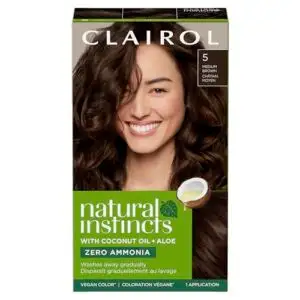
With your baby’s health in mind, Clairol Natural Instincts Medium Brown offers a gentler alternative to traditional dyes.
This semi-permanent option contains zero ammonia and is enriched with coconut oil and aloe vera to keep your hair soft while covering grays.
Its vegan, paraben-free formula lasts up to 28 shampoos, giving you lasting color without harsh chemicals.
You’ll appreciate how it fades gradually without obvious roots—perfect for pregnancy when you can’t maintain frequent touch-ups, making it a good choice for peace of mind.
While it may fade after several washes, many moms-to-be find this trade-off worth the peace of mind.
Best For: Pregnant individuals seeking a gentle, semi-permanent hair dye with a natural look and minimal chemical exposure.
- Zero ammonia formula with coconut oil and aloe vera for soft and conditioned hair.
- Vegan, paraben-free, and gentle enough for sensitive scalps.
- Gradual fading without harsh root lines, ideal for low-maintenance touch-ups.
- Color longevity varies, with some users reporting fading after a few washes.
- May cause uneven saturation or brassiness, especially in lighter shades.
- Less effective gray coverage compared to permanent dyes.
5. ONC Natural Black Hair Dye
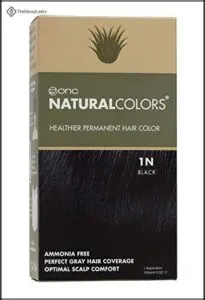
For expectant mothers concerned about hair color safety, ONC Natural Black Hair Dye offers a gentler approach.
This formula uses heat activation instead of harsh chemicals to open hair cuticles and deposit color.
You’ll appreciate its certified organic ingredients including argan oil, aloe vera, and chamomile.
It’s free from ammonia, parabens, and sulfates while featuring a low pH formula that minimizes scalp irritation—crucial during pregnancy.
With up to 90% naturally derived ingredients and vegan-friendly formulation, it’s a thoughtful choice when you’re looking for both effective color and peace of mind during pregnancy.
Best For: Individuals seeking a gentler, vegan-friendly hair dye solution with natural ingredients, particularly suitable for pregnant women or those with sensitive scalps.
- Contains certified organic ingredients like argan oil and aloe vera.
- Free from ammonia, parabens, and sulfates for a less harsh experience.
- Low pH formula helps reduce scalp irritation and potential hair damage.
- Mixed reviews on achieving desired color results, especially for gray coverage.
- Heat application process may feel inconvenient for some users.
- Concerns over "greenwashing" due to presence of some chemicals like PPD.
Hair Coloring and Breastfeeding
You’ll be relieved to know that coloring your hair while breastfeeding poses minimal risk, as very little of the chemicals are absorbed into your bloodstream or milk supply.
Just like during pregnancy, you can still follow the same safety precautions—using well-ventilated spaces and choosing gentler dye options—to further reduce any potential exposure to your baby.
Low Chemical Absorption Into Milk
Good news for new moms: research shows that chemical absorption into breast milk from hair dye is negligible.
Your body actually filters most hair dye chemicals before they can enter your bloodstream or milk supply.
The minimal dye transfer potential means infant exposure risk remains extremely low.
While breastfeeding and hair dye use can coexist safely, minimizing milk contamination is still recommended through proper application techniques.
Precautions for Breastfeeding Mothers
With breastfeeding and hair dye, it’s good to focus on minimizing infant exposure.
Use dye alternatives with gentle ingredients, and make certain proper application methods, like keeping dye off your scalp.
Since breast milk absorbs minimal chemicals, milk safety isn’t a big worry.
Highlighting your hair can further reduce chemical absorption.
Postpartum changes can affect results, so patch-testing your favorite product never hurts—and your hair will thank you!
Safe Hair Coloring Techniques
When coloring your hair during pregnancy, applying the right techniques can substantially reduce your exposure to chemicals. Always start with patch testing 48 hours before applying any hair dye while pregnant, even if you’ve used the product before.
Ventilation importance can’t be overstated—open windows and use fans to minimize fume inhalation. Stick to the shortest application duration recommended on the package, never leaving dye on longer than necessary.
For root touch-ups, focus only on new growth rather than reapplying to your entire head. Create protective barriers by applying petroleum jelly along your hairline to prevent skin absorption.
Consider ammonia-free dye options or try hair highlights during pregnancy since they don’t contact your scalp directly. To avoid issues, remember to detangle hair thoroughly before applying dye.
Remember, pregnancy safe dye techniques aren’t just about product choice—they’re about smart application methods that protect both you and your baby.
Choosing Gentle Hair Dyes
You’ll want to look for hair dyes that are free from ammonia, parabens, and phthalates to minimize chemical exposure during your pregnancy.
Plant-based options like henna or ammonia-free formulas specifically labeled "gentle" or "natural" can be your best friends during these nine months when your hormones might already be giving your hair a mind of its own.
Avoiding Harmful Chemicals
In your quest for pregnancy-safe hair dye, identifying and avoiding harmful chemicals should be your top priority.
When checking product labels, watch out for these potential troublemakers:
- Parabens and phthalates disrupt hormones and may affect fetal development
- Persulphates in bleaching products are linked to childhood leukemia risks
- Ammonia causes irritating fumes you’ll want to avoid
- Formaldehyde and resorcinol are suspected endocrine disruptors
- Synthetic fragrances often contain hidden phthalates
Look for paraben alternatives and ammonia-free dyes with organic ingredients and natural colorants instead.
Consider using safer dye options for your hair.
Consulting a Doctor for Advice
Everyone should consult their healthcare provider before using hair dye during pregnancy.
Your doctor can offer personalized recommendations based on your specific medical history and concerns.
| When to Consult | What to Discuss | Why It Matters |
|---|---|---|
| First Trimester | Treatment Timing | Highest sensitivity period |
| Any Trimester | Product Safety | Some ingredients may pose risks |
| Prior History | Allergic Reactions | Pregnancy can alter sensitivities |
| Ongoing Issues | Scalp Conditions | May affect dye absorption |
The table outlines key considerations for hair dye use during pregnancy, including the importance of discussing product safety and potential allergic reactions with a healthcare provider.
Frequently Asked Questions (FAQs)
What hair dye is safe while pregnant?
In terms of playing it safe, opt for ammonia-free products like Naturtint, Herbatint, or vegetable dyes. You’ll want to wait until your second trimester and always dye in well-ventilated areas.
How long should you wait to dye your hair after pregnancy?
You can safely dye your hair immediately after giving birth.
There’s no need to wait, as hair treatments don’t affect breastfeeding.
Just make certain of good ventilation and follow all product instructions for best results.
Can you get a Brazilian hair treatment while pregnant?
Brazilian hair treatments during pregnancy aren’t the best bet.
The formaldehyde fumes can affect you and your baby.
Opt for safer styling alternatives, and chat with your doctor for personalized advice before making decisions.
Can I get balayage while pregnant?
Balayage is generally considered safe during pregnancy since the dye doesn’t touch your scalp.
It’s best to wait until your second trimester and make certain the salon is well-ventilated for extra precaution.
Can hair dye affect babys hair color?
No, as clear as crystal, your hair dye won’t change your baby’s hair color.
The chemicals in hair dye don’t alter genetic traits, and they’re minimally absorbed through your scalp during pregnancy.
Do pregnancy hormones alter dye effectiveness?
Yes, pregnancy hormones can dramatically affect how hair dye works.
Your changing hormones might cause the color to absorb differently, resulting in unexpected shades or quicker fading than you’re used to.
Is root touch-up safer than full coloring?
When you’re sporting a little bump, root touch-ups can be a bit gentler on your system than full coloring since there’s less product contacting your scalp.
Reducing chemical absorption during your precious pregnancy journey is an important consideration, as it can impact your health and wellbeing.
How soon postpartum can I color hair?
You can generally color your hair immediately after giving birth, as chemicals won’t affect your baby through breastfeeding.
However, many doctors recommend waiting 4-6 weeks to allow your hormones to stabilize for better results, which can be influenced by the fact that chemicals won’t affect your baby through breastfeeding.
Will hair dye affect prenatal testing results?
Hair dye won’t affect your prenatal testing results.
The chemicals don’t interfere with blood work, amniocentesis, or ultrasounds.
You can color your hair without worrying about false readings on your important tests during pregnancy.
Conclusion
Like a color-preserving conditioner, your pregnancy journey requires careful attention to detail.
Remember, safe hair coloring during pregnancy isn’t about abandoning your beauty routine—it’s about adapting it thoughtfully.
You can still maintain your style while protecting your growing baby by following these expert tips, choosing the right products, and timing your treatments wisely.
When in doubt, always consult your healthcare provider, and your gorgeous locks will thank you, and so will your little one.

